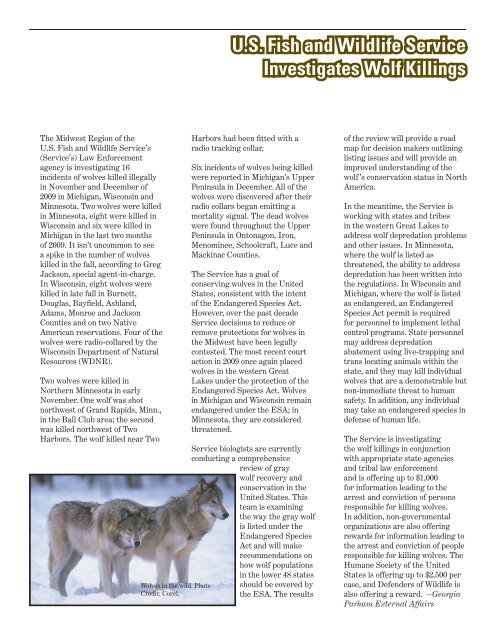February 2010 - U.S. Fish and Wildlife Service
February 2010 - U.S. Fish and Wildlife Service
February 2010 - U.S. Fish and Wildlife Service
You also want an ePaper? Increase the reach of your titles
YUMPU automatically turns print PDFs into web optimized ePapers that Google loves.
18<br />
The Midwest Region of the<br />
U.S. <strong>Fish</strong> <strong>and</strong> <strong>Wildlife</strong> <strong>Service</strong>’s<br />
(<strong>Service</strong>’s) Law Enforcement<br />
agency is investigating 16<br />
incidents of wolves killed illegally<br />
in November <strong>and</strong> December of<br />
2009 in Michigan, Wisconsin <strong>and</strong><br />
Minnesota. Two wolves were killed<br />
in Minnesota, eight were killed in<br />
Wisconsin <strong>and</strong> six were killed in<br />
Michigan in the last two months<br />
of 2009. It isn’t uncommon to see<br />
a spike in the number of wolves<br />
killed in the fall, according to Greg<br />
Jackson, special agent-in-charge.<br />
In Wisconsin, eight wolves were<br />
killed in late fall in Burnett,<br />
Douglas, Bayfi eld, Ashl<strong>and</strong>,<br />
Adams, Monroe <strong>and</strong> Jackson<br />
Counties <strong>and</strong> on two Native<br />
American reservations. Four of the<br />
wolves were radio-collared by the<br />
Wisconsin Department of Natural<br />
Resources (WDNR).<br />
Two wolves were killed in<br />
Northern Minnesota in early<br />
November. One wolf was shot<br />
northwest of Gr<strong>and</strong> Rapids, Minn.,<br />
in the Ball Club area; the second<br />
was killed northwest of Two<br />
Harbors. The wolf killed near Two<br />
Wolves in the wild. Photo<br />
Credit: Corel.<br />
U.S. <strong>Fish</strong> <strong>and</strong> <strong>Wildlife</strong> <strong>Service</strong><br />
Investigates Wolf Killings<br />
Harbors had been fi tted with a<br />
radio tracking collar.<br />
Six incidents of wolves being killed<br />
were reported in Michigan’s Upper<br />
Peninsula in December. All of the<br />
wolves were discovered after their<br />
radio collars began emitting a<br />
mortality signal. The dead wolves<br />
were found throughout the Upper<br />
Peninsula in Ontonagon, Iron,<br />
Menominee, Schoolcraft, Luce <strong>and</strong><br />
Mackinac Counties.<br />
The <strong>Service</strong> has a goal of<br />
conserving wolves in the United<br />
States, consistent with the intent<br />
of the Endangered Species Act.<br />
However, over the past decade<br />
<strong>Service</strong> decisions to reduce or<br />
remove protections for wolves in<br />
the Midwest have been legally<br />
contested. The most recent court<br />
action in 2009 once again placed<br />
wolves in the western Great<br />
Lakes under the protection of the<br />
Endangered Species Act. Wolves<br />
in Michigan <strong>and</strong> Wisconsin remain<br />
endangered under the ESA; in<br />
Minnesota, they are considered<br />
threatened.<br />
<strong>Service</strong> biologists are currently<br />
conducting a comprehensive<br />
review of gray<br />
wolf recovery <strong>and</strong><br />
conservation in the<br />
United States. This<br />
team is examining<br />
the way the gray wolf<br />
is listed under the<br />
Endangered Species<br />
Act <strong>and</strong> will make<br />
recommendations on<br />
how wolf populations<br />
in the lower 48 states<br />
should be covered by<br />
the ESA. The results<br />
of the review will provide a road<br />
map for decision makers outlining<br />
listing issues <strong>and</strong> will provide an<br />
improved underst<strong>and</strong>ing of the<br />
wolf ’s conservation status in North<br />
America.<br />
In the meantime, the <strong>Service</strong> is<br />
working with states <strong>and</strong> tribes<br />
in the western Great Lakes to<br />
address wolf depredation problems<br />
<strong>and</strong> other issues. In Minnesota,<br />
where the wolf is listed as<br />
threatened, the ability to address<br />
depredation has been written into<br />
the regulations. In Wisconsin <strong>and</strong><br />
Michigan, where the wolf is listed<br />
as endangered, an Endangered<br />
Species Act permit is required<br />
for personnel to implement lethal<br />
control programs. State personnel<br />
may address depredation<br />
abatement using live-trapping <strong>and</strong><br />
trans locating animals within the<br />
state, <strong>and</strong> they may kill individual<br />
wolves that are a demonstrable but<br />
non-immediate threat to human<br />
safety. In addition, any individual<br />
may take an endangered species in<br />
defense of human life.<br />
The <strong>Service</strong> is investigating<br />
the wolf killings in conjunction<br />
with appropriate state agencies<br />
<strong>and</strong> tribal law enforcement<br />
<strong>and</strong> is offering up to $1,000<br />
for information leading to the<br />
arrest <strong>and</strong> conviction of persons<br />
responsible for killing wolves.<br />
In addition, non-governmental<br />
organizations are also offering<br />
rewards for information leading to<br />
the arrest <strong>and</strong> conviction of people<br />
responsible for killing wolves. The<br />
Humane Society of the United<br />
States is offering up to $2,500 per<br />
case, <strong>and</strong> Defenders of <strong>Wildlife</strong> is<br />
also offering a reward. --Georgia<br />
Parham External Affairs

















